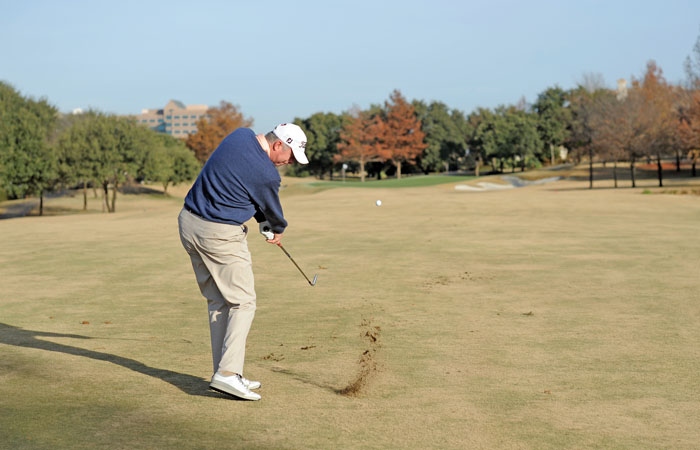There is nothing more frustrating than hitting your second shot on a par 5 on the fringe of the green, then blading the ball into the water over the green or chunking the ball a few feet in front of you, now turning your birdie into a bogey. If you’ve ever been in the situation of your ball being close to the green and ending up with a bogey or worse instead of saving par or getting up and down for a birdie, then this article is for you.
Setup is key when it comes to chipping; most students tend to stand too far away from the ball. To set up properly, have your feet a clubhead width apart at setup and stand closer to the ball, having your shaft more vertical at setup. Grip down on the club an inch more than normal. From here, your arms should be hanging down with just a little flex in your elbows. From here, the number one key is leaning on your lead side and having 80 percent of your weight on your lead side. This helps to hit your chip with a downward angle of attack, rather than upward like a driver.
To perform the drill, place a towel folded where it is half an inch or one inch in thickness and place the towel four to six inches behind the golf ball. From here, hit shots trying NOT to hit the towel. If you hit the towel, this can be because you stop rotating your body through impact, finishing with your chest facing the ball instead of facing the target. Another reason you hit the towel can be you have an ascending blow or upward angle of attack through impact, rather than descending angle of attack. Focus on hitting through the ball and the grass just in front of the golf ball to ensure you have a descending blow, instead of an ascending blow (hitting up on the ball). Another feeling to help with having a descending angle of attack can be to feel like you are going to stab the ground in front of the towel with the leading edge of the clubhead, rather than trying to lift the ball in the air and hit the ball. Always focus on swinging through the ball instead of at the ball.

Once you have practiced this several times, place your trail foot to the side with your heel up and all weight on your lead side. This will ensure you are keeping your weight on your lead side when you hit and not letting your weight fall back toward your trail side when you hit. Once you have done that several times, place an alignment stick on the lead side of your grip, acting as if it is an extension of your club, gripping the alignment stick and club together. The stick should be slightly in front of your lead rib cage at setup. Now that you are set up, hit shots, keeping the alignment stick in front of your body throughout the entire swing. If your hands are too active or you hit up on the ball, the alignment stick will hit you in the side. It is important that your chest, hands and clubhead all move together throughout the shot. Think of a triangle between your arms throughout the shot; it is important to keep that triangle throughout the entire swing.

After you have practiced hitting chip shots, gripping an alignment stick, having your trail foot to the side, and missing the towel, there is one more key to help you. If you find yourself hitting the ball fat or thin, often this tends to be a result of an upward angle of attack, and I have one more great drill to help this. Place an alignment stick in the ground at a 45-degree angle just above the ball, hit chip shots practicing missing the stick. If you hit the stick, this means you are hitting up on the ball (upward angle of attack); think of the clubhead finishing lower to the ground after you hit.

One last thought you can think about is having a longer backswing and a shorter follow through. After you practice these drills several times, you should see more consistency in contact on your chips, direction and distance control.
If you continue to struggle with inconsistency in your chipping, e-mail me at kirsten.pike@invitedclubs.com.